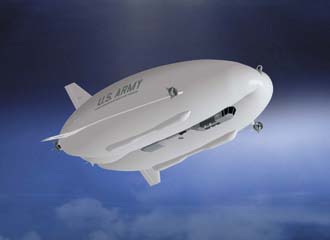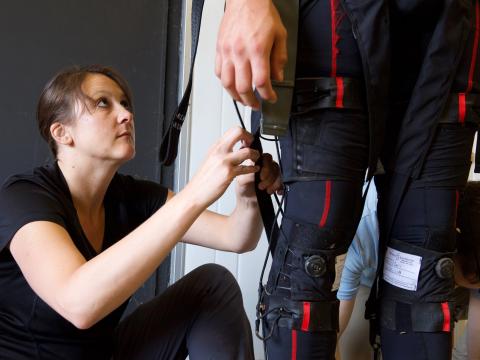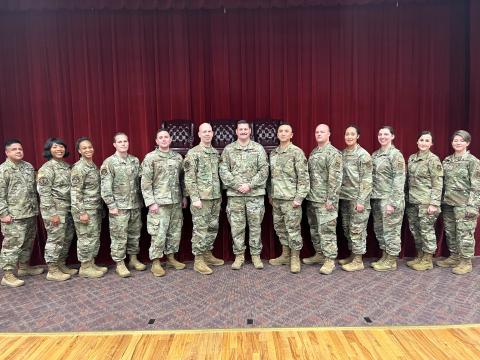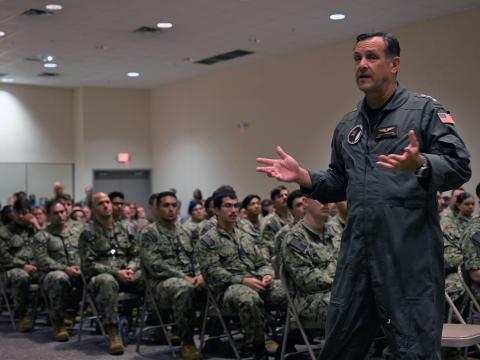Situational Awareness Surge Pays off on the Battlefield
The Long Endurance Multi-Intelligence Vehicle, a hybrid airship scheduled to begin fielding in Afghanistan in December, will add to the Army’s situational awareness with an array of sensors, including radar, signals intelligence, full-motion video and communications relays capabilities.
Forces benefit from an unprecedented effort for combat information. 
Warfighters in current operations now have better intelligence, surveillance and reconnaissance equipment at their fingertips as the result of a push from the highest levels of the U.S. Defense Department for rapid fielding. The equipment is providing more air and ground surveillance, improved intelligence, and greater network and data applications across the services and the coalition. Consequently, warfighters at all levels know and understand the combat situation and are able to make sound decisions more quickly.
“If you want to save time getting equipment to the field, have the number-three man in the Pentagon receive a briefing each month and in turn brief the secretary of defense on a monthly basis,” says Richard Wittstruck, chief systems engineer for the Army Program Executive Office, Intelligence, Electronic Warfare and Sensors. “When you have that level of interest, you get time saved all over the place.”
The high-level push for ISR capabilities has paid off on the battlefield, Army officials say. Unmanned air systems reached a major milestone in November, logging more than 1 million combat hours. In fact, 89 percent of total hours flown by unmanned systems have been in support of combat.
And while unmanned aircraft captures public attention, the humble aerostat has captured the respect of Army warfighters. According to Terry L. Mitchell, the senior ISR integration adviser to Lt. Gen. Rick Zahner, Army deputy chief of staff for intelligence, aerostats are less expensive, easier to operate and more easily deployed than manned or unmanned reconnaissance planes. “Aerostats have become an important player in this war. As we build these aerostats and put them out, it relieves the requirement to have a manned or unmanned ISR aircraft above them,” he says. Mitchell adds that the Army’s requirement has grown from nine aerostats a year ago between
And now, the Army intends to build and deploy the mother of all aerostats. The service awarded Northrop Grumman Corporation,
ISR aircraft and aerostats are important to warfighters in part because still imagery no longer is good enough, giving way to full-motion video, a capability increasingly demanded by warfighters. “When we looked at the threat before 9/11, we looked for mass formations. The technologies, tactics, techniques and procedures to fight that were really designed to identify bad guys going down the Fulda Gap,” Mitchell explains. “This war has changed that because we’re now focused on a networked adversary.” He adds that full-motion video is more capable of spotting explosive devices being planted on the roadside or other irregular warfare tactics. “You have to be able to watch. You have to understand the patterns of life. You have to understand the culture,” he notes.
The ISR surge also has resulted in greater ground surveillance capabilities, such as the Prophet Enhanced signals intelligence vehicle, which is housed on a Panther variant of the Mine Resistant Ambush Protected vehicle. Prophet Enhanced was fielded to soldiers at
In addition, the Afghan Mission Network (see page 19) has transformed the way the United States and its coalition partners—including Italy, the United Kingdom, Canada and others—share intelligence classified secret and below. The network formally was approved by NATO in early 2010 and reached initial operational capability in the summer.
Wittstruck relates that in doing this business for almost 25 years, he is happy and amazed at the level of disclosure the allies have brought to the table to make this mission more effective. “I guess the key is that it really starts with the leaders, who set the conditions for open dialogue,” he says.
The Afghan Mission Network was the brainchild of Gen. Stanley McChrystal,
U.S. Defense Secretary Robert Gates emphasized rapid deployment of the situational awareness technologies necessary to give friendly forces an edge over their adversaries. Ashton Carter, undersecretary of defense for acquisition, technology and logistics, and Lt. Gen. John “Jay” Paxton, USMC, operations chief for the Joint Chiefs of Staff, were tasked with identifying the equipment needed in theater and then getting it there quickly. The ISR Task Force was established to centrally manage doctrine, training, leadership, operations, materiel, personnel and facilities and to create a surge of ISR equipment into the war theater. Also created were the U.S. Army’s Task Force Observe, Detect, Identify and Neutralize (ODIN), and a push by the U.S. Air Force to field sensor-laden Project Liberty Aircraft rapidly. Both Task Force ODIN and Project Liberty conduct reconnaissance, surveillance and target acquisition missions to counter improvised explosive devices, the most lethal weapons employed against
Under the surge, ISR equipment rapidly is being developed, tested and fielded at every level. This year, the Army intends to begin low-rate initial production of Nett Warrior, a system of record follow-on to the cancelled Land Warrior program. The system started limited user testing last year with three companies—Rockwell Collins Incorporated, Raytheon Company and General Dynamics Corporation—providing prototypes. The Army’s goal is to reduce size and weight while increasing power capabilities for soldier communications, according to Maj. Doug Copeland,
“We are using combat-proven capabilities for Nett Warrior,” Maj. Copeland says, explaining that Land Warrior technologies have been combat-deployed three times, with the 4/9 Infantry Brigade, the 5th Brigade of the 2nd Infantry Division and the 2nd Cavalry. “We’ve had no incidents of fratricide with the three units it was fielded with,” he adds.
Mitchell shares that other technologies and capabilities that have proven necessary to take out a networked adversary include biometrics information and the ability to exploit documents recovered during missions. “These are things we’ve learned and have invested in heavily, which at the end of the day, takes out that network, reduces casualties and provides security to the populace,” he states. In fact, Mitchell says, the current conflict has pushed the need for intelligence gathering and analysis down to the lowest echelons. “In my day, the analysis was pretty much done at the division or above, but in this war, we’ve created company intelligence support teams within the maneuver company. They’re creating a lot of the information because they’re the ones providing the biometrics data and the document exploitation and having the first discussions with people of interest.”
The results of the ISR surge may influence future combat operations. “I’ve seen
The bottom line for some Army officials is that when they asked for help to win the war, they got it. “From an ISR point of view, the secretary of defense has enabled the services with budgeting and with leadership that has allowed us to increase our capability and meet this fight,” Mitchell says.
WEB RESOURCES
Program Executive Office, Intelligence, Electronic Warfare and Sensors: https://peoiews.monmouth.army.mil/default.htm
Office of the Secretary of Defense: www.defense.gov/osd
Central Command: www.centcom.mil



